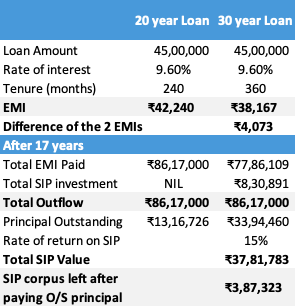Message: Would you like to meet up in Delhi NCR between 21st and 24th of September? Just reply to this email with your details and city of interest (Delhi, Gurgaon, Noida). Thanks!
Two months ago, I received an investment proposal. I was told that I should go for a 30 year home loan, instead of a 20 year one. The difference in EMI should be invested in mutual funds via the SIP route. This will enable me to pay my loan off much earlier and also leave some change in my pocket.
I shared the proposal with you and many readers made relevant and knowledgable comments on why this would not work.
Now, if you have not read the original investment pitch and the comments, please do it here.
Here is the image of how the original proposal looked like.

Anyone who looks at the numbers as mentioned is going for a 30 year loan. Seems like a no brainer.
But that’s where you came in to point out the loopholes.
The most important and incorrect assumption here is the rate of return. I mean a 15% (average annualised) rate of return is just too ambitious.
Last I checked, Nifty 500 Total Return Index delivered 11% approx CAGR (since inception). This was as on July 31, 2019.
The other factor is the uncertainty. I believe you referred to the volatility here, the sequence of returns which has the potential to change your final portfolio outcome.
So, I decided to do the math with this and see what are the chances that the salesman pitch comes out to be true.
Well, it is quite obvious that 15% is too much of a return, yet I decided to test it with scenarios of uncertainty – volatility and different sequence of returns. Well, no surprise.
At 15% what the salesman said has a high chance of coming true. Almost 90% chances that at the end of 17th year, the value of the SIP portfolio is higher than the principal outstanding. But no extra change in the pocket as he would have me believe.
But I know this is an unfair assumption. So, I worked with the 11% actual index return number.
Note: I am taking the Nifty 500 index fund as the investment vehicle with a 100% allocation to equity. This means no rebalancing required and no changes in the portfolio because of fund manager or costs.
See how the entire sales pitch comes cracking down.

Let’s talk about the 17th year first. After running 100s of scenarios of equity returns, there is only about a 10% chance that the SIP portfolio value will be higher than the principal outstanding.
Simply put, it is a pretty thin wire to walk on. Most likely, I will not have enough money to pay off the loan and live happily ever after as the salesman wanted me to believe.
Even at the end of the 20th year (the original loan tenure I was considering), there is only about 90% chance the equation matches. Good enough but not good enough.
It is only in the 25th year that it looks certain for the portfolio value to exceed the principal outstanding. I have already paid interest through my nose till then! In other words, taken for a really good ride.
Salesman pitch busted and my dreams too! 😉
What is the takeaway? What should I be doing?
Quite simple. Just take the 20 year loan. I will be much better off paying less interest (higher certainty).
With a 30 year home loan, I will only increase my period of slavery with the bank.
What do you say? The comments section is open.
Note on taxes: As a reader pointed out earlier, the LTCG on equity investment will shave off about a 1% from the returns. On this I say, we can just let the taxes on the fund gains and the tax benefits on the home loan cancel out each other. Keeps it simple.





[…] Update: Here’s the link to my analysis and conclusion. […]